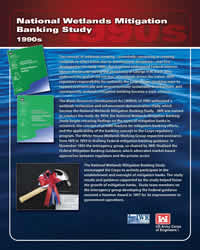 The concept of wetlands banking—essentially conserving or creating wetlands to offset losses due to development elsewhere—was first developed in the early 1980s. But it gained widespread Federal interest later in the decade during the presidency of George H.W. Bush, who endorsed the goal of “no net loss” of wetlands across the nation. With regulatory responsibility for wetlands, the Corps began studying ways to support economically and environmentally sustainable development, and consequently wetlands mitigation banking became a topic of focus.
The concept of wetlands banking—essentially conserving or creating wetlands to offset losses due to development elsewhere—was first developed in the early 1980s. But it gained widespread Federal interest later in the decade during the presidency of George H.W. Bush, who endorsed the goal of “no net loss” of wetlands across the nation. With regulatory responsibility for wetlands, the Corps began studying ways to support economically and environmentally sustainable development, and consequently wetlands mitigation banking became a topic of focus.
The Water Resources Development Act (WRDA) of 1990 authorized a wetlands restoration and enhancement demonstration study, which became the National Wetlands Mitigation Banking Study. IWR was named to conduct the study. By 1994, the National Wetlands Mitigation Banking Study began releasing findings on the types of mitigation banks in existence, the concept of private markets for mitigation banking efforts, and the applicability of the banking concept to the Corps regulatory program. The White House Wetlands Working Group requested assistance from IWR in 1993 in drafting Federal mitigation banking guidance. In November 1995 the interagency group, co-chaired by IWR, finalized the Federal Mitigation Banking Guidance, which advocated market-based approaches between regulators and the private sector.
The National Wetlands Mitigation Banking Study encouraged the Corps to actively participate in the establishment and oversight of mitigation banks. The study results and guidance supported by the study helped foster the growth of mitigation banks. Study team members on the interagency group developing the Federal guidance received a Hammer Award in 1997 for its improvements to government operations.
Learn More: